List of Olympic mascots facts for kids
The Olympic mascots are special characters, often animals or people, that represent the culture and spirit of the place hosting the Olympic and Paralympic Games. They are like friendly ambassadors for each event!
The idea of having an Olympic mascot started a long time ago. The 1932 Summer Olympics in Los Angeles had an unofficial mascot. But the first really famous mascot for the Summer Olympics was Misha the bear at the 1980 Summer Olympics in Moscow. Since the 2010 Vancouver Games, the mascots for both the Olympic and Paralympic Games have been introduced together.
Contents
The Story of Olympic Mascots
The very first Olympic mascot appeared at the 1968 Winter Games in Grenoble, France. It was called "Schuss," a small skier designed with the colors of France: blue, red, and white. However, the first official Olympic mascot was Waldi, a Dachshund dog, at the 1972 Summer Olympics in Munich. Waldi was a popular dog breed in Bavaria, Germany, and showed qualities like strength, determination, and quickness, which are important for athletes. Waldi even had three colors from the Olympic flag!
These early mascots were very popular. They helped the idea of a mascot become a key part of the Olympic Games. Mascots are usually simple, colorful, and cheerful, fitting the fun and celebratory mood of the Olympics. They also carry important messages about the host city and its culture.
Olympic Mascots Through the Years
| Games | City | Name | Type of Character | Meaning | Image | |
|---|---|---|---|---|---|---|
| 1932 Summer Olympics | Los Angeles | Smoky | Scottish terrier | An unofficial mascot born in the Olympic Village. |  |
|
| 1968 Winter Olympics | Grenoble | Schuss | Skier | An unofficial abstract skier in French colors. | 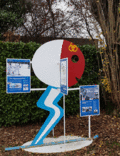 |
|
| 1968 Summer Olympics | Mexico City | Red Jaguar | Cat | An unofficial jaguar. | ||
| 1972 Summer Olympics | Munich | Waldi | Dachshund dog | A popular dog breed in Bavaria, showing strength and agility. | ||
| 1976 Winter Olympics | Innsbruck | Schneemann | Snowman | Represented the "Games of Simplicity." | ||
| 1976 Summer Olympics | Montreal | Amik | Beaver | One of Canada's national symbols. | ||
| 1980 Winter Olympics | Lake Placid | Roni | Raccoon | Its face looked like a competitor's hat and goggles. Named after the Adirondack Mountains. | ||
| 1980 Summer Olympics | Moscow | Misha (Миша) | Brown Bear | The bear was a national symbol of the Soviet Union. | 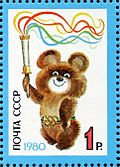 |
|
| 1984 Winter Olympics | Sarajevo | Vučko | Wolf | Showed humans wanting to be friends with animals. Changed how wolves were seen. | ||
| 1984 Summer Olympics | Los Angeles | Sam | Bald eagle | The symbol of the United States. | ||
| 1988 Winter Olympics | Calgary | Hidy and Howdy | Polar bears | Represented friendly Western Canadian people. | ||
| 1988 Summer Olympics | Seoul | Hodori (호돌이) | Siberian tiger | Common in Korean stories and legends. |  |
|
| 1992 Winter Olympics | Albertville | Magique | Man-star/snow imp | A unique, magical character. | ||
| 1992 Summer Olympics | Barcelona | Cobi | Catalan sheepdog | Designed in a modern, artistic style. | 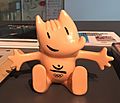 |
|
| 1994 Winter Olympics | Lillehammer | Håkon and Kristin | Humans | Dressed in Viking clothes. The first human mascots. | ||
| 1996 Summer Olympics | Atlanta | Izzy | Unknown | The first mascot made using computer graphics. | ||
| 1998 Winter Olympics | Nagano | The Snowlets: Sukki, Nokki, Lekki and Tsukki |
Owls | Represented Japan's four main islands. Their names combine to form "Snowlets." | ||
| 2000 Summer Olympics | Sydney | Olly (from "Olympic") |
Kookaburra | Showed the generous Olympic spirit. | ||
| Syd (from "Sydney") |
Platypus | Represented Australia's environment and people's energy. | ||||
| Millie (from "Millennium") |
Echidna | Represented the new millennium. All three are common Australian animals. | ||||
| 2002 Winter Olympics | Salt Lake City | Powder (a.k.a. Swifter) |
Snowshoe hare | All three were native animals of Utah. They were named after important natural resources and linked to local American Indian legends. | ||
| Copper (a.k.a. Higher) |
Coyote | |||||
| Coal (a.k.a. Stronger) |
American black bear | |||||
| 2004 Summer Olympics | Athens | Athena and Phevos | Brother and sister | Two modern children looking like ancient Greek dolls. | ||
| 2006 Winter Olympics | Turin | Neve and Gliz | Snowball and Ice cube | "Snow and Ice." Neve (snow) was a red snowball showing friendship. Gliz (ice) was a blue ice cube showing joy. |  |
|
| 2008 Summer Olympics | Beijing | The Fuwa (福娃): Beibei, Jingjing, Huanhuan, Yingying, Nini |
Koi, giant panda, Olympic Flame, Tibetan antelope, swallow | Their names together mean "Beijing welcomes you." Each represented an Olympic ring and a Feng Shui element. |  |
|
| 2010 Winter Olympics | Vancouver | Miga | Sea Bear | Part orca (killer whale) and part kermode bear. | 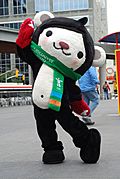 |
|
| Quatchi | Sasquatch | From Canadian myths and legends. | 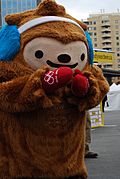 |
|||
| Mukmuk | Vancouver Island marmot | Not an official mascot, but their special "sidekick". | ||||
| 2012 Summer Olympics | London | Wenlock | A drop of steel with a camera for an eye. | Named after a village that hosted early Olympic-style games. Showed the UK's Industrial Revolution. |  |
|
| 2014 Winter Olympics | Sochi | Bely Mishka (Polar Bear), Snow Leopard (leopard), Zaika (the dore hare) (Леопард, Зайка, Белый Мишка) | The first mascots chosen by a public vote. |  |
||
| 2016 Summer Olympics | Rio de Janeiro | Vinicius | A mix of all Brazilian mammals | Inspired by Brazilian animals. Named after a famous poet. | ||
| 2018 Winter Olympics | Pyeongchang | Soohorang (수호랑) | A white tiger | A white tiger, a symbol of trust, strength, and protection in Korean stories. | 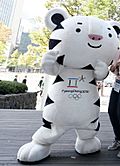 |
|
| 2020 Summer Olympics | Tokyo | Miraitowa (ミライトワ) | Robot | A superhero-like robot showing old traditions and new ideas. Chosen by Japanese schoolchildren. | ||
| 2022 Winter Olympics | Beijing | Bing Dwen Dwen (冰墩墩) | Panda | A panda in an ice suit, sharing the Olympic spirit. | ||
| 2024 Summer Olympics | Paris | The Olympic Phryge | Phrygian cap | Based on the Phrygian Cap, a symbol from the French Revolution. | ||
| 2026 Winter Olympics | Milan–Cortina d'Ampezzo | Tina | Ermine | Named after Cortina d'Ampezzo, one of the host cities. | ||
| 2028 Summer Olympics | Los Angeles | TBA | TBA | TBA | TBA | |
| 2030 Winter Olympics | TBA | TBA | TBA | TBA | TBA | |
| 2032 Summer Olympics | Brisbane | TBA | TBA | TBA | TBA |
Youth Olympic Mascots
The Youth Olympic Games also have their own special mascots!
| Games | City | Name | Type of Character | Meaning | Picture | |
|---|---|---|---|---|---|---|
| 2010 Summer Youth Olympics | Singapore | Lyo and Merly | Red male lion (Lyo), Blue female merlion (Merly) | Represented Singapore as the "Lion City" and its national symbol, the Merlion. |  |
|
| 2012 Winter Youth Olympics | Innsbruck | Yoggl | Alpine Chamois | Yoggl showed the spirit of the host city. |  |
|
| 2014 Summer Youth Olympics | Nanjing | Lele(砳砳) | Yuhua Stone | Inspired by "Rain-Flower Pebbles" from the host city. "Lele" sounds like the Chinese word for happiness. | ||
| 2016 Winter Youth Olympics | Lillehammer | Sjogg | Lynx | A lynx, a wild cat found in the region. |  |
|
| 2018 Summer Youth Olympics | Buenos Aires | Pandi | Jaguar | A young jaguar. Its name combines its scientific name and the idea of the "digital world." |  |
|
| 2020 Winter Youth Olympics | Lausanne | Yodli | A cow, Saint Bernard dog and a goat hybrid. | Named after a yodeling singing style. Yodli is a mix of animals common in the Swiss mountains. |  |
|
| 2024 Winter Youth Olympics | Gangwon Province | Moongcho | A snowball born from a snowball fight between Soohorang and Bandabi. | A playful snowball character. |  |
|
| 2026 Summer Youth Olympics | Dakar | TBA | TBA | TBA | TBA |
See also
 In Spanish: Mascota de los Juegos Olímpicos para niños
In Spanish: Mascota de los Juegos Olímpicos para niños
- List of mascots
- Olympic symbols
- Paralympic mascots
- Paralympic symbols



